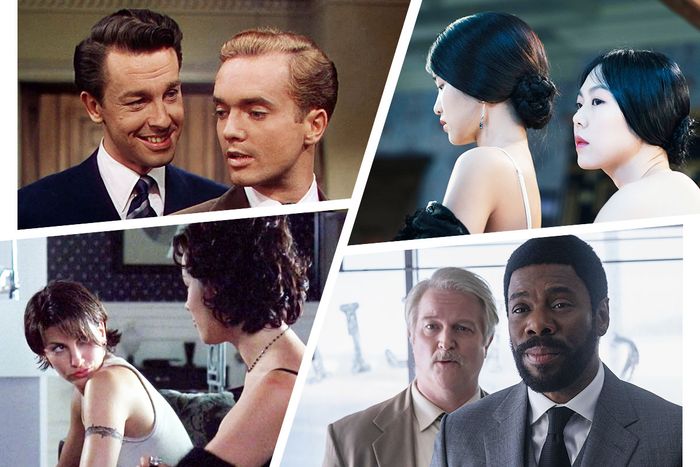
When it feels like the world’s against you, you’ve got to rise up and take action. That’s something queer people have been doing in cinema since the beginning: kicking ass, doing crime, and shaking up a society that feels built to discard them. Queerness and crime manifest themselves in different ways in cinema’s history: Lawbreaking can be a last-ditch effort to make an impact; a desire to integrate into society or remain further from the mainstream; a glorious revenge on heteronormative society — or it can just be really freaking fun.
Queerness and activism have long been intertwined. From the Stonewall riots in 1969 and divisions of ACT-UP throughout the world during the AIDS crisis, LGBTQ+ communities have long rallied together for their rights to live a life unencumbered by hatred and unfair laws. With activism comes resistance and fighting back against the unjust. Sometimes, it’s argued, the only way to make your voice heard is to shake things up. Thus the motto embraced by queers online: “Be gay, do crime.”
But the tongue-in-cheek phrase also has a surprisingly long-standing cinematic tradition — before characters could be explicitly gay onscreen, queer-coded icons paved the way through con-artistry and murder. With the latest entrant in the BGDC canon, Drive-Away Dolls, in cinemas this weekend, it’s a great time to reflect on the queer criminals that have shaped cinema.
Sylvia Scarlett (1935)
This madcap adventure finds Sylvia Scarlett (Katharine Hepburn) dressing in drag and becoming Sylvester Scarlett to avoid the police and keep up a life of crime with her con-man father. The film was a box-office disaster and critically dismissed. Even Hepburn thought it was awful: “I don’t understand how it could be a cult picture because it’s hopeless,” she told the BBC. Well, Katharine, you can blame the gays. Watching Hepburn prance around as Sylvester, kissing women, committing crimes, and remaining in drag far longer than her character has to be, is one of the great pleasures of queer film-going.
Dracula’s Daughter (1936)
“Save the Women of London From Dracula’s Daughter!” one poster of Universal’s Dracula’s Daughter begs, the first film to incorporate the lesbian vampire so popular in literature. The plot is flimsy, but Gloria Halden is sensational as Countess Zaleska, the titular vampire longing to be free of her vampiric curse. She struggles to fight off her bloodlust but doesn’t relent on her desire for other women. Surprisingly, the sensually sapphic sequence of Zaleska seducing Lili (Nan Grey) made it past censors. It’s a tragic story with evocative gothic imagery of a woman who just wants to love other beautiful women without being hunted.
Rope (1948)
Set in a single apartment, Hitchcock’s queer thriller, Rope, finds Brandon (John Dall) and Phillip (Farley Granger) staging the perfect murder, strangling their old friend in their penthouse. They hide the body in plain sight — in a wood chest in their apartment, where they’re about to host a dinner party. While Brandon and Phillip are gay in the play Rope is based on, the film (or rather, the Hays Code) prevented that from being possible onscreen in the 1940s. But it’s not exactly subtle — the men share an apartment and are attracted to the finer things in life. Rope isn’t just tightly wound suspense unfolding in real time, but a striking metaphor for the struggle of a closeted existence.
Les Diaboliques (1955)
Few filmmakers mastered suspense like Henri-George Clouzot, who made perhaps the most nerve-shredding film in existence with 1953’s The Wages of Fear. He followed that up with the sensational Les Diaboliques, another master class of unbearable tension. Two women are fed up with school headmaster Michel (Paul Meurisse): his wife, Christina (Véra Clouzot), and his mistress, Nicole (Simone Signoret). Naturally, the pair come together with a solution — murder him. The film removes the sapphic relationship from the novel, but the movie’s queer subtext is undeniable, just like the sexual tension between Christina and Nicole in the film.
The Servant (1963)
Barrett (Dirk Bogarde) manipulates his way into the home of Tony (James Fox), where he works as his dutiful and devoted servant, before scamming him and revealing his true intentions. The Servant is stunningly modern, slowly morphing into a bitter domestic drama, with the pair bickering like they’re an old married couple — think a queered reflection of Who’s Afraid of Virginia Woolf?. The cinematography is outstanding, allowing Tony’s home to first feel enormous in scope before becoming wickedly claustrophobic as time goes on. Tony and Barrett’s relationship grows increasingly parasitic as the film reaches a fever pitch. They don’t seem to be able to live with each other — but they can’t live without each other, either.
Funeral Parade of Roses (1969)
There’s an astonishing sensitivity and empathy behind the masterpiece Funeral Parade of Roses, a movie that would feel ahead of its time in 2024 let alone when it came out in 1969. This experimental Japanese film entwines documentary with a time-jumping fictional narrative of Eddie and her fellow gender-non-conforming people working at a gay bar in Tokyo. Funeral Parade of Roses isn’t interested in a shadowy, miserable queerness, instead letting its characters live full, vibrant lives that aren’t exclusively defined by trauma. Come for the spectacular imagery — a shot of three trans women using urinals wearing skirts is immortal — and stay for the bloody Oedipus twist.
Female Trouble (1974)
Frankly, most of this list could be films by John Waters. American cinema’s most exciting transgressor made his most compelling collaboration with drag queen Divine in Female Trouble. Dawn Davenport (Divine) asks for cha-cha heels for Christmas, but when she doesn’t get them, she runs away from home. All she wants is to be famous, and the easiest way for Dawn to get notoriety is to follow a life of violent and increasingly shocking crimes. Female Trouble is raunchy, disgusting, and imminently watchable — right until its electrifying conclusion. It’s also got a valuable message to share: As one character claims, “Queers are just better.”
Dog Day Afternoon (1975)
It was supposed to be easy. Sonny (Al Pacino) and Sal (John Cazale) are to get into a bank, steal the money, and get out. But like many great heist movies, things prove vastly more complicated. What first feels like a straightforward bank robbery with typical masculine machismo reveals itself as something more unique and, importantly, queer: Sonny has organized the robbery to get his lover, Leon, gender-reassignment surgery. Dog Day Afternoon showcases the staggering barriers in accessing gender-affirming care. (The only way Sonny sees a way to get his partner the surgery they require is to turn to crime.) It’s also a reminder of how devoted queer people can be — hell hath no fury like a Sonny scorned.
Desperate Living (1977)
The Pope of Trash outdid even his own limits of nastiness with Desperate Living. After murdering her husband, Peggy Gravel (Mink Stole) and her maid/accomplice, Griselda Brown (Jean Hill), run off to Mortville, a wayward society of depraved miscreants and criminals ruled by the fascist Queen Carlotta (Edith Massey). Between the sex scenes that will be seared in your mind forever, truly rancid meals, and extremely committed performances, John Waters weaves a gross, violent, and hilarious tapestry that also functions as a bold queer manifesto, celebrating freedom from oppression.
Cruising (1980)
Controversial before it was even released, William Friedkin’s Cruising finds Al Pacino going undercover as Steve Burns to try and find a killer tearing through New York City gay bars. Kinky, confounding, and unafraid to confront homophobia, Friedkin’s film is incredibly specific to the ’80s yet maintains a surprising sense of timelessness; it’s a dense thriller that peels back layers with a sophisticated delight. A scathing indictment of the police and how challenging it is to be taken seriously as a gay man, Cruising is a furious, brutal film with lascivious sequences of Pacino taking poppers and dancing like nobody’s watching.
Born in Flames (1983)
In this radical call-to-arms, Lizzie Borden’s Born in Flames imagines a faux-socialist government running America, where promises of equality never came to fruition. Women of all races, classes, and sexualities band together in the Women’s Army and pirate radio groups to turn the political tides, beating up troublemaking men, and hijacking television broadcasts to get their message across. Borden’s film is gorgeously composed and thrillingly DIY work, as she was only able to shoot once a month when she managed to scrounge $200 together. Radiating queer energy, it’s a searing agitprop that’s no less timely than it was in 1983.
The Living End (1992)
“Fuck the world.” That’s the motto of Luke (Mike Dytri) and Jon (Craig Gilmore), two HIV-positive gay men who meet in tremendously unconventional circumstances. Gregg Araki’s The Living End is an 84-minute destructive middle finger to society and a vital piece of the New Queer Cinema movement. The film is filled with anger and frustration over the overwhelming silence of the government’s response to the AIDS crisis. With nothing to lose, Jon and Luke hit the road, a last-ditch lovers-on-the-run effort fueled by gun violence and sex to take whatever they can from life — before it’s taken from them. There’s a tenderness between the pair that lives within that bubbling frustration, which makes The Living End all the more impactful.
Fresh Kill (1994)
Shareen (Sarita Choudhury) and Claire (Erin McMurty) live with their daughter near a Staten Island landfill. Due to corporate malfeasance, pollution has overwhelmed the city, leading to disturbing cases of radioactivity. When their daughter starts turning neon green and vanishes, the couple schemes to hack the GX Corporation to get their daughter back and expose them as the monsters they are. This fiercely independent film boasts fantastic sets and paints a tremendously vivid image of its grim, curious world: “Our waterways have become the world’s largest oil reserves,” one TV host laments. A clever, no-holds-barred critique of corporate capitalism, Fresh Kill only grows more prescient with our increasing environmental panic.
Chocolate Babies (1996)
Bold and confrontational, Stephen Winter’s Chocolate Babies follows a largely HIV-positive group of queer activists. Fed up with political inaction, they terrorize politicians on the streets in a desperate bid to have their voices heard: “We are Black faggots with a political agenda” they shout while accosting a councillor. Winter’s film doesn’t shy away from the tragedy, trauma, and overwhelming fear of these vibrant souls racing against time they don’t have, but it’s also careful to celebrate the gorgeous individuality and vitality of these queer lives. The film is largely forgotten — and never received much distribution outside festivals — but the director has uploaded the film to Vimeo.
Bound (1996)
Before The Matrix, Lana and Lily Wachowski wrote and directed Bound, a lesbian neo-noir thriller. Former convict Corky (Gina Gershon) is hired to renovate an apartment building. Next door, she finds Violet (Jennifer Tilly), who is stuck in a loveless marriage to a money launderer. Violet falls for Corky, and the pair plans to run off together with a cool $2 million — money that belongs to the Mafia. For Violet and Corky, crime promises tantalizing freedom from the weight of a heteronormative society. The Wachowskis are known for big, visionary sci-fi swings, but Bound suggests they’re at their best working in a smaller, claustrophobic, and infinitely more erotic register.
Stranger by the Lake (2013)
Speaking of erotic, few films have intrepid horniness coursing through their veins like Alain Guiraudie’s Stranger by the Lake. This single-location film takes place at a French cruising spot by (you guessed it) a lake. Franck (Pierre Deladonchamps) finds himself utterly enamored with Michel (Christophe Poau) — a man he witnesses doing something unspeakably violent. But that doesn’t stop Franck, who’s determined to pursue Michel despite the most egregious red flag imaginable. Sexually explicit and unrelenting in its depiction of the darkness of desire, Stranger by the Lake is an intoxicatingly sexual cat-and-mouse thriller by way of European art house.
Eastern Boys (2013)
A lonely middle-aged gay man gets a lot more than he bargained for when he cruises a much younger man at a Paris train station in Eastern Boys. Robin Campillo’s film flirts with various genres, first appearing as a home-invasion movie before shifting into something more heartfelt and romantic, with a third-act twist that takes things to an unexpected conclusion. Thrilling and creative, Eastern Boys explores the vulnerabilities faced by queer immigrants, revealing the humanity of people who are rarely given that opportunity onscreen.
The Handmaiden (2016)
Few films easily bring together sumptuous visuals and mind-bending plot twists like Park Chan-wook’s The Handmaiden. The concept is straightforward: A man and a woman attempt to scam a heiress out of her vast fortune. But the film is vastly more complicated. Written by Park and regular collaborator Jeong Seo-kyeong, The Handmaiden explores multiple timelines, languages, and perspectives as it untangles a delicately layered heist. The chemistry between Kim Tae-ri and Kim Min-hee is scintillating, and a cabal of brilliant performances helps some of the more preposterous reveals feel completely grounded and believable. The Handmaiden delivers a gloriously heightened fantasy full of intricately conceived turns and lesbians having a lot of fun breaking the law.
Can You Ever Forgive Me? (2018)
With her writing career on the outs, Lee Israel (Melissa McCarthy) turns to a life of forgery, creating fake letters by various historical celebrities. Both McCarthy and Richard E. Grant — playing her friend/partner in forging, Jack — are sublime, weaponizing their characters’ queerness to get a step up in a world that’s effectively abandoned them. Crime feels good in a place like this, with both Lee and Jack relishing their newfound roles in counterfeit-letter writing. Lee in particular thrives in these circumstances, allowing her to express her abilities in ways her previous biographies couldn’t offer.
Plagiarism and You(Tube) (2023)
On the surface, a four-hour video about plagiarism shouldn’t be that interesting — especially if, like me, you aren’t familiar with a single person it’s referencing. But hbomberguy’s searing exposé of James Somerton, a video essayist with a consistent history of stealing from queer writers and passing it off as his own work, is arresting. This isn’t just an endlessly fascinating story of how entrenched plagiarism is on the platform or the crushing impact of stealing queer writing and passing it off as your own. Over four perfectly paced hours, hbomberguy weaves together evidence with extraordinary craftsmanship, making the case that YouTube video essays contain some of the most compelling storytelling in any medium.
Drive-Away Dolls (2024)
The latest addition to the “Be Gay, Do Crime” canon puts a fun twist on the trope. A pair of lesbians on a road trip is blissfully unaware of the wrongdoing they’re committing in Drive-Away Dolls. Jamie (Margaret Qualley) and her bestie, Marian (Geraldine Viswanathan), pick up a car to deliver to Tallahassee, but they have no idea the car is holding something important — and sinister — within it. A buddy-comedy-cum-lesbian-sexfest, Ethan Coen and Tricia Cooke’s joyous romp is an easy-breezy blast. It wears its queerness as a giddy badge of honor, offering a psychedelic and hilarious bend on being gay and doing crime.




